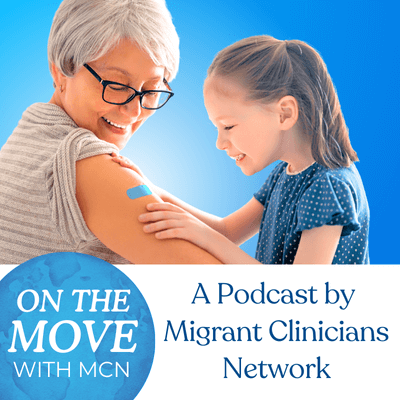Start Prescribing Paxlovid, Please! Immigrants & Migrants Need Access.

[Editor’s Note: This blog post is an excerpt from the most recent update of our regularly updated “FAQ: COVID-19 and Migrant, Immigrant, and Food & Farm Worker Patients,” which will be released tomorrow.]
Paxlovid, the highly effective treatment against COVID infection, is underprescribed in the US, particularly for the underserved. For example, Hispanic populations were 30% less likely to be prescribed Paxlovid, compared with white populations.
After a careful review of the patient’s prescriptions to avoid negative drug interactions, clinicians should prescribe Paxlovid for those within the first five days of their COVID-19 infection. But many are choosing not to. This is a mistake, particularly for the most at-risk populations.
Migrant and immigrant patients who have poor access to care and vaccines need access to Paxlovid.
The CDC notes that “some people from racial and ethnic minority groups are at risk of being disproportionately affected by COVID-19 from many factors, including limited access to vaccines and healthcare. Health care providers can consider these factors when evaluating the risk for severe COVID-19 and use of outpatient therapeutics.”
It is concerning how many patients are reporting that their primary care providers are refusing to prescribe Paxlovid, when its safety and effectivity are well understood. We strongly encourage clinicians to use this lifesaving tool in the outpatient setting, to prevent hospitalizations, severe disease, and long COVID. Please refer to the following questions for patient and provider concerns on Paxlovid:
Paxlovid Concern: “It’s only for high-risk people.”
Paxlovid is not only for high-risk people.
Any outpatient infected with COVID-19 may get Paxlovid if they are:
- 50 years old or older (a change from previous CDC recommendations), OR
- Is not up to date on their vaccinations, OR
- With any condition that may complicate an infection – like asthma, cirrhosis of the liver, diabetes, obesity, physical inactivity, smoking, and many others.
For example, anyone over 50, regardless of risk, is eligible. People of any age with a risk factor may not feel they are “high risk” but are still eligible for Paxlovid.
Paxlovid Concern: “I’m not eligible.”
California made headlines when its Public Health Officer recommended that anyone who is symptomatic and wants Paxlovid should seek treatment. That’s because many people have risk factors that they don’t realize – including being physically inactive or overweight; being a current or former smoker; having a mood disorder including depression; and having hypertension or a substance use disorder. These and a list of other risk factors like diabetes, heart disease, and hypertension are listed by the CDC.
Paxlovid Concern: “COVID rebound makes it not worth it.”
A percentage of people who take Paxlovid find that their symptoms improve, but days or even weeks later, symptoms and/or detectable virus return. This percentage may be around 10%, but in one small study, 24% of Paxlovid-takers had symptom rebound after initial improvement. However – and most critically -- those who rebound do not generally go to the hospital. For anyone whose COVID may progress to life-threatening, Paxlovid is a lifesaver, even with rebound. There is also a small percentage of patients with COVID, who do not take Paxlovid, who experience rebound.
Paxlovid Concern: “COVID isn’t severe anymore, so I’ll just wait it out.”
Over 2,500 people die each week in the US of COVID. The virus is killing more people than any other infectious disease, and for the third year in a row was the third-largest killer in the US, only behind heart disease and cancer. While the numbers have dropped from the January 2021 high of 23,000 deaths a week, 2,500 deaths per week remains stark. Additionally, there are other reasons besides hospitalization that a patient may choose Paxlovid. One is that the risk of long COVID is reduced by 25% among patients who take Paxlovid.
Paxlovid Concern: “The side effects on the kidneys aren’t worth it.”
Many people are reporting that they are unable to get a prescription unless the patient undergoes a kidney screening while positive with COVID and feeling very ill. For patients with known kidney concerns – like kidney disease or who are on dialysis – Paxlovid is not recommended. “Since Paxlovid is cleared by the kidneys, dose adjustments may be required for patients with mild-to-moderate kidney disease,” says a Yale Medicine article. Across the world, farmworkers and other outdoor workers who work in extremely high temperatures have experienced chronic kidney disease and/or acute kidney injury that may lead to chronic kidney disease if persistent. Clinicians serving farmworkers should take an occupational history to uncover any unknown kidney injury. However, for generally healthy patients with no known kidney health concerns or risk factors, a kidney screening is not warranted.
Paxlovid Concern: “I’m vaccinated so I don’t need it.”
A vaccinated individual should consider Paxlovid if the person has any other risk factors. People who were vaccinated several months ago should strongly consider Paxlovid as the antibodies associated with the vaccine may be waning.
Paxlovid Concern: “It’s toxic.”
There is widespread misinformation about the toxicity of Paxlovid. It does not cause any major side effects or death. Minor side effects like changes in taste and the poor or metallic taste of the pills themselves may have propelled these rumors. “But, says Michael Ganio, director of pharmacy practice and quality at the American Society of Health System Pharmacists, ‘a bad taste for five days is a small price to pay for a drug that can save your life.’”
Read the CDC’s COVID-19 Treatments and Medications page for more information: https://www.cdc.gov/coronavirus/2019-ncov/your-health/treatments-for-severe-illness
- Log in to post comments





